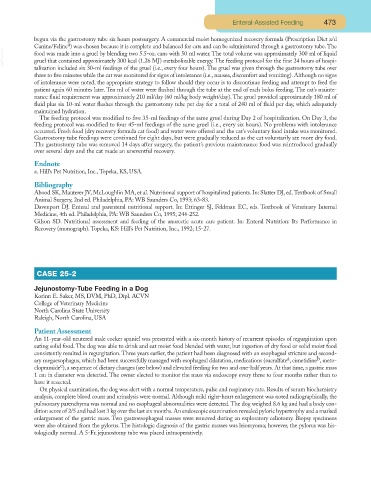Page 459 - Small Animal Clinical Nutrition 5th Edition
P. 459
Enteral-Assisted Feeding 473
begun via the gastrostomy tube six hours postsurgery. A commercial moist homogenized recovery formula (Prescription Diet a/d
a
Canine/Feline ) was chosen because it is complete and balanced for cats and can be administered through a gastrostomy tube.The
VetBooks.ir food was made into a gruel by blending two 5.5-oz. cans with 50 ml water. The total volume was approximately 300 ml of liquid
gruel that contained approximately 300 kcal (1.26 MJ) metabolizable energy. The feeding protocol for the first 24 hours of hospi-
talization included six 30-ml feedings of the gruel (i.e., every four hours). The gruel was given through the gastrostomy tube over
three to five minutes while the cat was monitored for signs of intolerance (i.e., nausea, discomfort and vomiting). Although no signs
of intolerance were noted, the appropriate strategy to follow should they occur is to discontinue feeding and attempt to feed the
patient again 60 minutes later. Ten ml of water were flushed through the tube at the end of each bolus feeding. The cat’s mainte-
nance fluid requirement was approximately 210 ml/day (60 ml/kg body weight/day). The gruel provided approximately 180 ml of
fluid plus six 10-ml water flushes through the gastrostomy tube per day for a total of 240 ml of fluid per day, which adequately
maintained hydration.
The feeding protocol was modified to five 35-ml feedings of the same gruel during Day 2 of hospitalization. On Day 3, the
feeding protocol was modified to four 45-ml feedings of the same gruel (i.e., every six hours). No problems with intolerance
occurred. Fresh food (dry recovery formula cat food) and water were offered and the cat’s voluntary food intake was monitored.
Gastrostomy tube feedings were continued for eight days, but were gradually reduced as the cat voluntarily ate more dry food.
The gastrostomy tube was removed 14 days after surgery, the patient’s previous maintenance food was reintroduced gradually
over several days and the cat made an uneventful recovery.
Endnote
a. Hill’s Pet Nutrition, Inc., Topeka, KS, USA.
Bibliography
Abood SK, Mauterer JV, McLoughlin MA, et al. Nutritional support of hospitalized patients. In: Slatter DJ, ed.Textbook of Small
Animal Surgery, 2nd ed. Philadelphia, PA: WB Saunders Co, 1993; 63-83.
Davenport DJ. Enteral and parenteral nutritional support. In: Ettinger SJ, Feldman EC, eds. Textbook of Veterinary Internal
Medicine, 4th ed. Philadelphia, PA: WB Saunders Co, 1995; 244-252.
Gilson SD. Nutritional assessment and feeding of the anorectic acute care patient. In: Enteral Nutrition: Its Performance in
Recovery (monograph). Topeka, KS: Hill’s Pet Nutrition, Inc., 1992; 15-27.
CASE 25-2
Jejunostomy-Tube Feeding in a Dog
Korinn E. Saker, MS, DVM, PhD, Dipl. ACVN
College of Veterinary Medicine
North Carolina State University
Raleigh, North Carolina, USA
Patient Assessment
An 11-year-old neutered male cocker spaniel was presented with a six-month history of recurrent episodes of regurgitation upon
eating solid food. The dog was able to drink and eat moist food blended with water, but ingestion of dry food or solid moist food
consistently resulted in regurgitation. Three years earlier, the patient had been diagnosed with an esophageal stricture and second-
b
a
ary megaesophagus, which had been successfully managed with esophageal dilatation, medications (sucralfate , cimetidine , meto-
c
clopramide ), a sequence of dietary changes (see below) and elevated feeding for two and one-half years. At that time, a gastric mass
1 cm in diameter was detected. The owner elected to monitor the mass via endoscopy every three to four months rather than to
have it resected.
On physical examination, the dog was alert with a normal temperature, pulse and respiratory rate. Results of serum biochemistry
analysis, complete blood count and urinalysis were normal. Although mild right-heart enlargement was noted radiographically, the
pulmonary parenchyma was normal and no esophageal abnormalities were detected. The dog weighed 8.6 kg and had a body con-
dition score of 2/5 and had lost 3 kg over the last six months.An endoscopic examination revealed pyloric hypertrophy and a marked
enlargement of the gastric mass. Two gastroesophageal masses were removed during an exploratory celiotomy. Biopsy specimens
were also obtained from the pylorus. The histologic diagnosis of the gastric masses was leiomyoma; however, the pylorus was his-
tologically normal. A 5-Fr. jejunostomy tube was placed intraoperatively.

